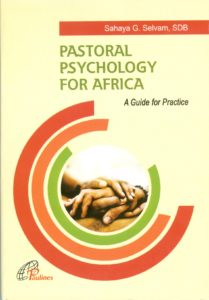 Selvam, S.G. (2019). Pastoral psychology for Africa: A guide for practice. Nairobi: Paulines Africa.
Selvam, S.G. (2019). Pastoral psychology for Africa: A guide for practice. Nairobi: Paulines Africa.
READ: AN ACADEMIC REVIEW OF THIS BOOK
In pastoral practice, good will is not good enough. We also need a scientific approach. Psychology can provide a framework for a systematic approach in pastoral care.
Psychology for Pastoral Practice in Africa is designed to offer a scientific framework for Christian ministry in traditional societies such as Africa. The approach is ecumenical and Catholic. It is scholarly and accessible.
The book has 30 chapters grouped into five parts:
1. Psychology and Pastoral Care
2. The Person of the Pastoral Practitioner
3. Along Life-Long Development
4. Anomalous and Religious Experiences
5. Groups and Individuals
Outline of a Typical Chapter
Each chapter discusses one particular problem or situation in the pastoral context, sheds light on the problem by having recourse to a theory or model from scientific psychology and proposes implications for pastoral practice. Accordingly, each chapter has three major sections: Phenomenon, Principle, and Practice. The three sections are informed by the method of what is referred to as the Pastoral Cycle or Pastoral Circle: See, Judge/Reflect and Act. Every chapter begins with what we see in terms of the phenomenon or a situation in the pastoral context. We evaluate that situation in the light of sound psychology in this case and propose plan for action.
1.Phenomenon
This section of the chapter introduces the problem or a situation emerging from the pastoral context. This is carried out by describing a case, or an anecdote, or a hypothetical situation. These cases have a resemblance to real life; sometimes they are historical narratives, and other times, they are just hypothetical accounts. They are presented in such a way as to describe different dimensions of the situation.
2. Principle
The second section of the chapter interprets the situation in the light of a sound psychological theory or model, with an aim of understanding and explaining the situation. Generally, the focus is on one major theory; sometimes the interpretation is drawn from several related theories. The aim here is not meant to be exhaustive but relevant. In exploring the theory, its proponents, dimensions, and supporting evidences are briefly presented. The theory is presented, as far as possible, in accessible, non-technical language.
3. Practice
Finally, based on the theory, some pastoral implications are pointed out. This targets specifically the African context. The general focus is the pastoral practice in any Christian context.
4. Further Reading
Throughout the book, I try to use a language that is popular and less technical, as said above, but sometimes technical language has been necessary due to the scientific character of the work. The text of the chapter has only a few intext references. The intext references provide evidence for the arguments, and offer suggestions for further scholarly work, particularly among students of pastoral theology. There is a complete list of references at the end of the book that includes full detail of sources cited. There is also a list of sources at the end of each chapter offering suggestions for further reading. Just looking up on Google Scholar or a standard e-resources database on the names of cited authors could give access to further valuable material.
How to use this book?
The target readership of the book is pastoral practitioners in the field, and those preparing themselves for any form of caring ministry in Africa. The pastoral practitioners could include: parish ministers, chaplains, deacons, pastoral counsellor, Christian nurses and doctors, extraordinary ministers; the list could be endless. As said earlier, the text targets pastors/ministers of all Christian traditions, being sensitive to their situations, even if some topics will be specific to the Catholic tradition. There is a special focus in this edition of the book on the context of Africa. Almost all these observations could be extended to Christianity in the Global South, and most reflections would be meaningful and applicable in Christian contexts where there is a large number of people from traditional cultures.
The book could be used as a text-book in seminary formation for pastoral theology, and pastoral psychology in particular. It could also be used by pastoral practitioners for ongoing formation. Certain chapters could be taken-up for discussion among ministers in their meetings and common days of prayer and reflection.